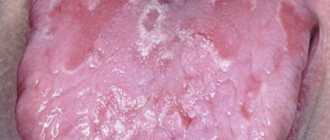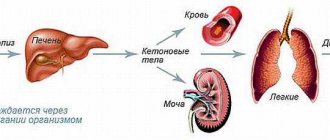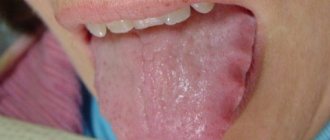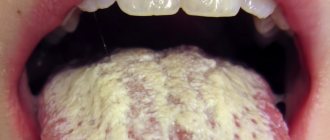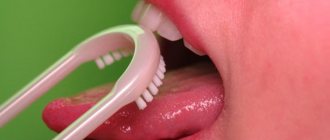Causes of geographic spots on the tongue
Geographic tongue is a disease manifested by dystrophic and inflammatory processes in the mucous membrane of the tongue.
The condition is characterized by alternating areas of peeling and thickening on the surface of the tongue. You should know why a child develops a geographic tongue and what parents need to do in this case. Causes of the disease:
- lack of B vitamins;
- diseases of the gastrointestinal tract (gastritis, gastroduodenitis, malabsorption syndrome, pancreatitis);
- endocrine diseases;
- autoimmune diseases (systemic lupus erythematosus, rheumatoid arthritis, multiple sclerosis);
- severe forms of viral infection;
- exudative diathesis, colds;
- diseases of the oral cavity.
Blood diseases, nervous disorders and autonomic-endocrine disorders are also the causes of geographic spots on the tongue. In children, the disease is often a companion to helminthic infestation. Predisposing factors include heredity and diseases of the spleen.
Treatment methods
The tactics for treating ulcers on a child’s tongue depends on the type of disease and its course.
Aphthous stomatitis
The most common disease is aphthous stomatitis.
The following reasons can provoke its development:
- Sometimes the aphthous form of stomatitis in a child is often confused with the herpes virus
stress;
- genetic factor;
- lack of vitamins;
- allergy;
- folic acid deficiency.
Sometimes the aphthous form of stomatitis in a child is often confused with the herpes virus.
Mistakes can be avoided by carefully monitoring the development of the disease.
With stomatitis, at the initial stage, red dots form, after which white and gray bubbles with a red rim form in their place. Ulcers appear after the blisters burst.
To treat aphthous stomatitis, an integrated approach is used, including:
- systematic procedures for rinsing the mouth with decoctions of medicinal plants (calendula, chamomile, tea tree, etc.) and solutions of potassium permanganate, lugol;
- local treatment of affected areas of the mucous membrane with pharmacological agents (for example, methyluracil ointment).
The duration of treatment depends on the severity of the disease and the regularity of the procedures.
Herpetic stomatitis
Drug treatment is prescribed by a doctor, taking into account the characteristics of the body and the degree of neglect of the disease.
Treatment of the disease in its advanced form is carried out in a pediatric hospital or infectious diseases department.
Mild cases of herpetic stomatitis are carried out on an outpatient basis, but the child is isolated from others due to the fact that he is a carrier of the virus.
Drug treatment is prescribed by a doctor, taking into account the characteristics of the body and the degree of neglect of the disease.
Among the recommended drugs:
- antiviral (Acyclovir, Zovirax, Oxolinic ointment, etc.);
- antihistamines (Cetirizine, Loratadine, Fenistil);
- anti-inflammatory (Ibuprofen, Paracetamol);
- wound healing (solutions of Trypsin or Chymotrypsin);
- antiseptic (Solutions of Chlorhexidine, Furacilin);
- immunostimulating (Imudon, echinacea extract, etc.).
In case of acute or recurrent stomatitis of the herpes form, physiotherapy or laser therapy procedures are also prescribed.
Thrush (candidiasis)
Starting at six months of age, doctors prescribe topical antifungals
Choosing a treatment method for babies is quite difficult, because babies cannot describe their symptomatic sensations.
The mother needs to closely monitor the child to understand the cause of thrush.
If this is regurgitation after eating, then it is worth reducing the diet or keeping the baby upright for 20 minutes every time after eating.
It is equally important to maintain hygiene and sanitary standards in your home.
The following methods are used to treat infants:
- treatment of the oral mucosa with a cotton swab dipped in soda solution (1 tsp per 200 ml of warm water);
- wiping the oral mucosa with gauze soaked in a weak solution of potassium permanganate.
It is advisable to carry out procedures at an early stage of the development of a fungal infection, then the chances of recovery double. Pediatricians rarely prescribe antifungal agents for infants.
Starting from six months of age, doctors prescribe topical antifungals. When the disease progresses to a severe form, an integrated approach is used, which combines internal and local drugs.
The following drugs are used to treat older children:
- Miramistin (ointment, solution);
- Nystatin (tablets);
- Diflucan (tablets);
- Clotrimazole (ointment, tablets), etc.
Allergy
Most often, the allergen is found in foods, hygiene products, and medications.
Red ulcers on a child’s tongue may appear as a result of the body’s reaction to an allergen (causative agent).
There is no point in treating the consequences; the main thing is to identify the product or substance that caused the formation of wounds on the tongue as quickly as possible.
Most often, the allergen is found in foods, hygiene products (you need to carefully study the composition), and medications.
Dental fillings, dentures, and braces can also provoke an allergic reaction.
Gastrointestinal problems
In infants, the digestive system is still at the stage of formation, so the gastrointestinal tract is very sensitive to many irritants.
Any failures provoke a violation of the absorption of nutrients into the blood, against which vitamin deficiency develops, spots and ulcers appear on the tongue.
Another reason for changes in microflora are antibiotics, so they are prescribed in combination with drugs containing beneficial bacteria.
The essence of treating ulcers comes down to eliminating problems in the gastrointestinal tract and treating the lesions with special local agents.
Tongue injuries
Scarlet ulcers can also appear on a child’s tongue as a result of injury:
- careless use of a toothbrush;
- biting the tongue with teeth;
- tissue injury from sharp edges of a damaged tooth or filling;
- due to the eruption of baby teeth;
- poor-quality installation of the prosthesis when correcting the bite, etc.
Treatment of wounds in such cases consists of eliminating the irritant and local treatment of the lesions with wound-healing agents.
Symptoms of the disease
Symptoms most often appear on the back and side of the tongue. The disease is characterized by alternating areas of desquamation of the epithelium and thickening of the mucosa, resulting in whitish-gray and bright pink spots. In appearance they resemble a geographical map.
There are no obvious symptoms in this case. The condition is usually diagnosed when a patient is examined for another pathology. In rare cases (especially when eating spicy, hot and salty foods), the patient may complain of:
- change in tongue sensitivity;
- burning and tingling sensation;
- itching;
- discomfort while eating.
On our website Dobrobut.com you can make an appointment with a doctor and get answers to all your questions. If necessary, the specialist will prescribe additional diagnostics and a course of treatment after receiving the examination results.
Symptoms of the disease
The first symptom of the disease is the appearance of grayish spots on the mucous membrane of the tongue, which quickly increase in size. As they grow, the epithelium in the center of such formations sloughs off and the bright red surface of the papillae is exposed. The spots take on the appearance of rings or half rings. The tongue has a motley appearance, and the pattern on its surface resembles a geographical map (hence the name of the disease).
The duration of the disease varies among patients. After treatment, it may disappear forever, or it may become recurrent with periodic exacerbations.
90% of cases of the disease occur without any symptoms. Occasionally, a child may complain of a slight burning sensation or numbness in the tongue, increased sensitivity to sour foods. Only with the addition of a secondary infection may general symptoms appear: fever, pain in the mouth, weakness, malaise.
If geographic tongue brings discomfort and unpleasant sensations, and signs of infection appear, then an urgent consultation with a dentist is necessary.
Diagnosis and treatment of geographic tongue in an adult
Diagnosis of the disease in most cases does not cause difficulties. The diagnosis is made after a thorough examination and history. In some cases, consultation with a dentist and gastroenterologist will be required.
When making a diagnosis in adults, an extensive examination is necessary. When collecting anamnesis, the presence of chronic diseases and allergic manifestations, as well as the state of the immune system, is taken into account. Taking all this into account, the doctor will prescribe a course of treatment for geographic tongue in an adult and monitor its implementation.
Preventive measures
Diseases characterized by the formation of ulcers on the tongue can be avoided if preventive measures are taken in a timely manner:
- If, after the measures taken, ulcers appear on the tongue again, it is recommended to undergo a more thorough examination.
visit the dentist regularly;
- Brush your teeth and mouth twice a day with high-quality toothpaste;
- teach your child to rinse his mouth after every meal to remove small particles;
- strictly adhere to restrictions regarding the consumption of foods that cause an allergic reaction;
- develop a diet so that it contains 65-70% fresh vegetables and fruits;
- take vitamin complexes to maintain immunity;
- protect the child from stress.
If, after taking measures, ulcers appear on the tongue again, it is recommended to undergo a more thorough examination. This sign may indicate problems with the digestive system or other diseases.
Treatment of pathology
Drug therapy is aimed at eliminating the underlying cause. Geographic tongue is not an independent disease, but a condition that signals serious problems in the body.
Additional events:
- sanitation of the oral cavity;
- exclusion of salty, spicy and hot foods from the diet;
- alkaline rinses, local applications with anesthetic;
- prescription of antihistamines;
- prescription of multivitamin complexes.
If you strictly follow the doctor’s recommendations, the prognosis for the disease is favorable.
Traditional medicine recommends using oak bark decoction, calendula or chamomile decoction as rinses. You can also use propolis (applied to the affected areas), vegetable oil (oral baths) and honey.
Treatment
Most doctors (for example, Komarovsky) believe that geographic tongue does not require any specific therapy, especially if it does not cause any discomfort. The main point of the successful disappearance of the disease in this case is the elimination of the possible cause of its appearance.
But what to do if a child has complaints? In this case, treatment is carried out without surgery, aimed at restoring the epithelium on the mucous membrane of the tongue, eliminating pain and preventing inflammatory complications. All events are held at home.
The use of drugs with keratolytic and analgesic effects is indicated (Keratolin, oil solution of vitamins A and E). To speed up recovery processes, Solcoseryl ointment is prescribed. To prevent infection, rinse with antiseptic solutions (Chlorhexidine, Miramistin).
Complications and prevention
Geographic tongue is not an independent disease, but its appearance signals serious disturbances in the functioning of the body. The sooner you contact a specialist, the sooner adequate treatment will be prescribed. Timely therapy is a guarantee of a high-quality cure for the disease.
In childhood, complications are very rare.
Preventive actions. Fighting bad habits, taking vitamins in the spring and autumn, adequate treatment of gastrointestinal diseases and timely sanitation of the oral cavity will help avoid this condition.
Book a consultation with our specialists and find out how to treat geographic tongue disease.
How to treat ulcers at home - traditional methods
As an additional treatment for ulcers on the tongue, you can use traditional medicine recipes:
- It is effective to use mouth rinses with home-prepared decoctions of plants that have antiseptic properties (calendula, sage, St. John's wort, viburnum berries, rose hips, chamomile, linden flowers). The brewing technology is simple - a tablespoon of dry plant is poured with 250 ml of boiling water. The container with the lid closed is left for 30-40 minutes. After filtering, you can carry out procedures. The oral cavity should be treated at least 5 times throughout the day. Keep the liquid in your mouth for about a minute each time you rinse.
- Ulcers will heal faster if they are treated with wound healing agents. These are mainly essential oils: sea buckthorn, calendula, rose hips, as well as aloe and Kalanchoe juices. They need to be applied pointwise, capturing only the affected tissue.
- Among the effective recipes, a solution based on soda , salt, iodine stands out (3 drops of iodine and a teaspoon of bulk ingredients per 200 ml of water). Applications and rinsing should be carried out at least 3-4 times a day for a week.
It is difficult to carry out medical procedures for babies less than a year old, and not all traditional methods can be used.
Therefore, the following treatment options for tongue ulcers have long been used for them:
- treatment of lesions with hydrogen peroxide;
- wiping the oral cavity, including the tongue, with a mixture of milk (100 ml), one yolk and honey (1 tsp);
- taking yarrow juice with honey (1 spoon 3 times a day for 3 weeks);
- processing with a mixture of egg white and water.
In what cases is it necessary to consult a doctor?
If you use folk recipes when identifying ulcers, you can get rid of them without the help of a doctor. But at the same time, the child’s condition must be stable.
If after a week’s treatment the lesions do not dry out or, in addition to them, other alarming symptoms appear (temperature, fever), then you should not hesitate to visit the clinic.
